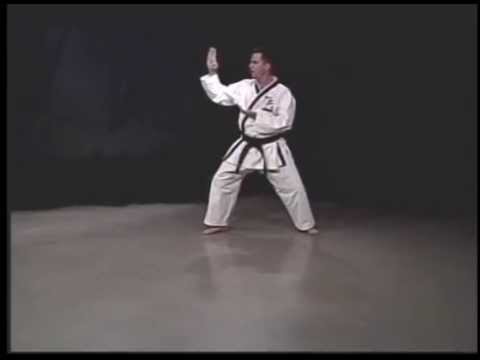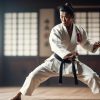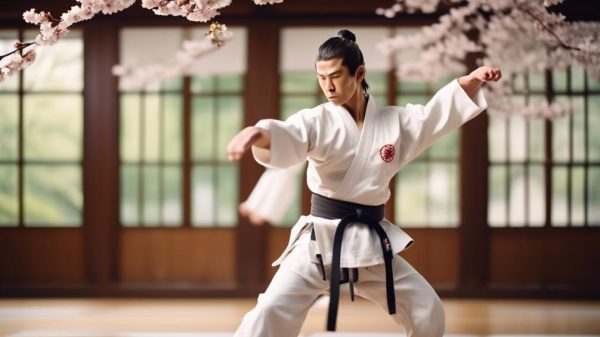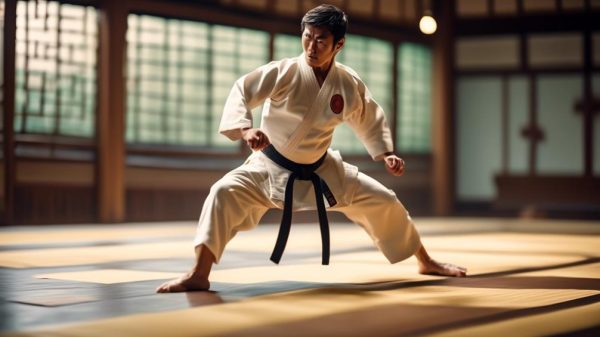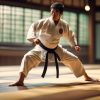Yoo-Sin is a complex Taekwondo pattern honoring a great Korean commander. Practicing the 68 motions boosts fitness and courage like the brave General Yoo-Sin.
Following the Yoo-Sin sequence develops better reaction time, speed, stamina, and body control. Smooth transitions between hand, foot, blocking, and hitting techniques requires precision timing.
Shifting stances quickly works balance, strength, and focus. Students must stay centered while twisting or turning kicks, punches and defensive motions.
Paying close attention to detail keeps movements aligned on all sides and angles. Strict standards reflect the pattern’s namesake commander’s disciplined leadership style.
Embodying General Yoo-Sin’s valor, students gain confidence plus well-rounded coordination from dedicating themselves to this elaborate form.
Key Takeaways
- Mastering the 68 motions aims to instill the courageous spirit and resolute character of historic General Yoo-Sin it was named after.
- Developing quick reactive responses is trained through smoothly transitioning between diverse offensive and defensive techniques in motion.
- Shifting stances and weight distribution in motion stresses dynamic balance and strength building needed in Taekwondo.
- Angled steps and kicks in multiple directions enhance mobility and body unity in initiating attacks from different orientations.
- Precise hand positioning, stance rigidity, and technique alignment on all sides builds attention to detail reflecting General Yoo-Sin’s discipline.
- Committing to perfect the elaborative combinations advances endurance, control, and mental fortitude. Incremental refinement matters most.
- Visualizing flowing sequences with a partner provides applications for reactive self-defense amid attacks from varying distances and angles.
Training in General Yoo-Sin’s namesake form perpetuates traditional martial arts values of courage, discipline, and determination for self-improvement.
History of Yoo Sin Form
The Yoo Sin form in Taekwondo has a rich history that dates back to General Kim Yoo Sin, a respected figure from the Silla Dynasty.
This form represents the unification of Korea and is practiced by black belts at the 3rd-degree level in ITF Taekwondo.
With its 68 movements, Yoo Sin symbolizes the year Korea was united, showcasing the indomitable spirit and strength of the Korean people.
Each stance and strike in this form holds historical significance, allowing practitioners to pay homage to the past while demonstrating their technical skills.
The ready posture itself carries a profound meaning, representing the act of drawing a sword from the right, in remembrance of General Kim Yoo Sin’s mistake of fighting against his own nation.
By mastering Yoo Sin, practitioners embrace the essence of Taekwondo America, incorporating not just physical prowess but also the spiritual and historical depths of this martial art.
Key Movements and Techniques
Mastering the key movements and techniques of the Yoo Sin form in Taekwondo America requires precision and focus. In ITF Taekwondo, the Yoo-Sin form consists of dynamic sequences of punches, blocks, and kicks. To execute this form with mastery, one must focus on the fluidity and continuity of these movements.
Proper stances such as L-stance, sitting stance, and fixed stance are essential for powerful and balanced techniques. The incorporation of upset punches, middle blocks, front strikes, waving kicks, and outward blocks demonstrates the diverse skill set required for this form.
Strikes like horizontal strikes, crescent kicks, and side-piercing kicks demand precision and control. The execution of 9-shape blocks and downward strikes adds depth and complexity to the form, requiring practitioners to exhibit both strength and finesse.
Through dedicated practice and focus, one can truly embody the principles of Taekwondo America through the Yoo Sin form.
Philosophy of Yoo Sin
Embodying the philosophy of Yoo Sin in Taekwondo America requires a deep understanding of the form’s historical significance and the values it represents. To truly grasp the essence of Yoo Sin, you must internalize the following:
- Courage and Leadership: General Kim Yoo Sin’s unwavering bravery and exceptional leadership are reflected in the form’s movements. It inspires you to embody these qualities not only in your training but also in your everyday life.
- *Imagine yourself standing tall, exuding confidence, and leading by example.*
- *Feel the surge of courage coursing through your veins, empowering you to face any challenge head-on.*
- Perseverance and Determination: Yoo Sin’s dynamic and powerful techniques embody the spirit of perseverance and determination. They teach you to push past your limits and embrace the relentless pursuit of excellence.
- *Sense the unyielding strength and determination propelling you forward with every strike.*
- *Embrace the mindset of never giving up, no matter how tough the journey becomes.*
Yoo Sin in Taekwondo America
Incorporating Yoo Sin into the practice of Taekwondo America requires a deep understanding of its historical significance and a dedication to embodying its values in both training and everyday life. Yoo Sin is a form within ITF Taekwondo that holds great importance in Taekwondo America, particularly for practitioners who hold the rank of 2nd Degree Decided black belt.
This form not only demonstrates technical skill, but also encompasses the fundamental principles of Taekwondo, such as discipline, focus, and self-confidence. The movements within Yoo Sin demand precision, fluidity, and power, reflecting the practitioner’s journey toward mastery.
When performing Yoo Sin in Taekwondo tournaments, the focus is on accuracy, execution, timing, rhythm, and precision. Judges assess the practitioner’s ability to convey the essence of the form through these elements. Mastering Yoo Sin enhances strength, flexibility, coordination, and concentration, contributing to the overall development of an individual in the practice of Taekwondo.
To fully integrate Yoo Sin into your Taekwondo America training, it’s important to seek guidance from instructors and diligently practice the movements outlined in the curriculum. This commitment won’t only improve your technical skills, but also instill the philosophical and historical significance of Yoo Sin into your journey as a Taekwondo practitioner.
Training Tips for Yoo Sin
Training Tips for Mastering Yoo Sin
To become proficient in Yoo Sin, concentrate on honing your movements with precision and power, enhancing both your physical skills and philosophical journey in the world of Taekwondo. Remember that training encompasses not only the physical aspect but also the mental and emotional aspects.
Here are some tips to guide you on your path:
- Pay attention to the details:
- Consider each movement carefully, ensuring that you execute each technique with precision and power. This won’t only impress judges in competitions but also showcase your mastery of the form.
- Embrace the philosophy:
- Delve into the deeper meaning behind each movement. Yoo Sin isn’t just a series of physical actions, but a representation of discipline, focus, and inner strength. Embracing this philosophy will enrich your training experience and help you embody the true spirit of ITF Taekwondo.
Benefits of Practicing Yoo Sin
Practicing Yoo Sin offers numerous physical and mental benefits. It not only improves strength, flexibility, and coordination but also enhances focus, concentration, and self-confidence. Mastering this form of Taekwondo goes beyond martial arts skills, as it instills discipline, respect, and perseverance through dedicated practice. The following table highlights the key advantages of practicing Yoo Sin, encompassing both physical and mental benefits:
| Physical Benefits | Mental Benefits |
|---|---|
| Strength | Focus |
| Flexibility | Concentration |
| Coordination | Self-confidence |
| Endurance | Self-defense abilities |
Yoo Sin Form Variations
Dive into the various Yoo Sin form variations in Taekwondo, each showcasing unique movements and techniques tailored to different organizations’ curricula. As you explore these variations, you may feel a sense of excitement, discovering distinct stances and movements that expand your repertoire of techniques.
Anticipate the differences in Yoo Sin form variations within ITF Taekwondo and Taekwondo America, fostering eagerness to delve deeper into the intricacies of each variation.
Remember that each Yoo Sin form variation offers a pathway to mastery. Embrace the challenge of understanding and embodying the unique elements of each variation, as this will enhance your technical prowess and deepen your appreciation for the art of Taekwondo.
Frequently Asked Questions
How Do You Memorize Taekwondo Forms?
To memorize Taekwondo forms, visualize and practice each movement in your mind. Repeat the movements to develop muscle memory. Break down the steps and use mnemonic techniques to make remembering easier. Becoming a master of the forms requires dedication and deliberate practice.
What Are the Black Belt Forms?
To become proficient in black belt forms in Taekwondo, you will learn advanced techniques that demonstrate your belt progression. These forms have a rich history in martial arts and require discipline, precision, and a combination of strength and grace.
What Is Taekwondo Form Called?
The taekwondo form known as Yoo-Sin holds significant historical importance and cultural influence. Practicing this form offers various benefits such as discipline, strength, and self-confidence. Mastering Yoo-Sin demonstrates a strong dedication to the art of taekwondo.
What Are the Taekwondo Patterns Called?
Taekwondo patterns, also known as forms, are essential for demonstrating your skills in this martial art. They incorporate fundamental techniques, advanced kicks, and strategies for sparring. Mastering these patterns is like unlocking the secrets of martial arts expertise.

